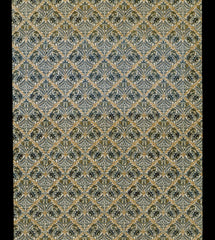Indian influences on William Morris
William Morris was aware of the pattern designs of India and spent much time browsing the collections at the South Kensington Museum (now the V&A). Some of his pattern forms are influenced by the structure of Indian patterns including, Indian Diaper (1876), Pomegranate (1877) and Little Chintz (c.1889).

Morris wanted to perfect the traditional Indian production processes himself and worked with Thomas Wardle to achieve this goal. Wardle was already well-versed in Indian fabrics and traditional dyes made from plant materials. They set up works in Merton Abbey so Morris could experiment with the indigo discharge process (the indigo plant creates blue dye). A bleach paste is painted onto the surface to certain areas when the fabric is dipped into the indigo dye. The bleached areas are then separately dyed to create the design. His pattern The Strawberry Thief (1883) was the first success using this process. He also enjoyed using madder, a natural red dye made from roots.

